|

Lesbian
Nation
First
Run Features,
2009
Carmelita
Tropicana:
Your Kunst Is Your Waffen
Jumping the Gun
Little Women In Transit
Playing the Part
Lavender Limelight:
Lesbians In Film
Unrated, 139 minutes
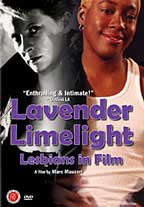
Lavender
Limelight:
Lesbians In Film
First
Run Features,
1996
Director:
Marc Mauceri
Starring:
Jennie Livingston,
Rose Troche,
Monika Treut,
Maria Meggenti,
Su Friedrich,
Heather Lyn MacDonald,
Cheryl Duyne
Unrated,
56 minutes
|
Shorts
Ala Sappho
by
Michael D. Klemm
Posted online, June, 2009

Lesbian
Nation
is an intriguing anthology of lesbian-themed short films, each released
during the mid-1990s as LGBT films began to proliferate into a major genre
onto itself. As I wrote a few months ago, when I reviewed a few gay short
film collections, the nice thing about shorts is that they are, well...
short. With the exception of the documentary that concludes this DVD,
each of these filmmakers understands that these little vignettes are not
meaty enough to sustain a feature film and they are all to be commended
for not trying to do so. Shorts are the perfect venue to explore non-epic
ideas and, oftentimes, a nice way to just have fun. The final film, a
documentary entitled Lavender Limelight: Lesbians On Film, is also
available as a separate, stand-alone DVD with additional directors' bios.
|
|
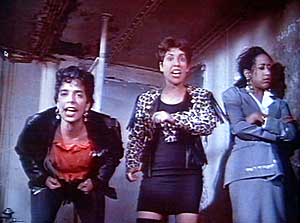 Carmelita
Tropicana: Your Kunst Is Your Waffen, 1994
Carmelita
Tropicana: Your Kunst Is Your Waffen, 1994
Director: Ela Troyano
Screenplay: Alina Troyano, Ela Troyano
Starring: Alina Troyano, Livia Daza-Paris, Anne Iobst, Sophia Ramos,
John Lanzillotto
27 minutes
Leading off this
anthology is the extremely funny Carmelita
Tropicana: Your Kunst Is Your Waffen. Directed and co-written
by - and also starring - Cuban-born Alina Troyano (1997's Latin Boys
Go To Hell), this delightful short was originally produced for public
television's Independent Television Service (ITVS). Troyano stars as a
Latina performance artist named Carmelita Tropicana who is mugged while
walking home from one of her shows. She wakes up the next morning to a
pair of frantic phone calls. One is from her father, the other from the
leader of an activist group. It seems that Carmelita is late for a counter-protest
in front of an abortion clinic but first she has to stop to fix the boiler
because her upstairs tenant is out of hot water.
|
|
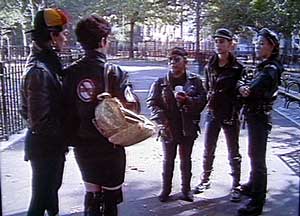 Carmelita
rushes with her girlfriend to the clinic just as things are beginning
to get ugly . A posse, consisting entirely of middle-aged white men, is
screaming epithets like "You Lezzie Commie Baby Killers!" The leather-clad
dynamic duo is arrested, along with Carmelita's conservative sister and
they are thrown into a jail cell with the woman who mugged Carmelita the
night before. The rest of the film is a delicious send-up of women's prison
movies, feminist activism, Broadway musicals and patriarchal Latin archetypes. Carmelita
rushes with her girlfriend to the clinic just as things are beginning
to get ugly . A posse, consisting entirely of middle-aged white men, is
screaming epithets like "You Lezzie Commie Baby Killers!" The leather-clad
dynamic duo is arrested, along with Carmelita's conservative sister and
they are thrown into a jail cell with the woman who mugged Carmelita the
night before. The rest of the film is a delicious send-up of women's prison
movies, feminist activism, Broadway musicals and patriarchal Latin archetypes.
Troyano's small character
touches are wonderful. The straight sister is first seen reading a magazine
entitled For Today's Hispanic Woman which dispenses "fashions tips
for corporate success" such as not wearing big gold earrings or Steak
Tartar lipstick. (What she is wearing, of course, violates every rule
in the magazine.) Just to annoy her sister, who is furious that she is
in jail, Carmelita and her activist girlfriend break into a dance, singing:
|
"We're here! Who's
here?
GIA! G-I-A!
We're anti-sexist, anti-racist
And very very lesbian and gay!
In The fight Roe Versus Wade
Eggs And Ovaries!
Eggs And Ovaries!
They're Mine! All Mine!
We win the fight for equal rights!
Uh-huh! Uh-huh! Uh-huh Uh-huh Uh-huh!"
|
|
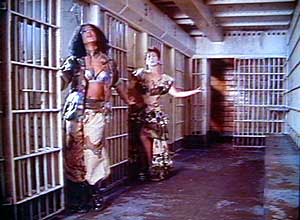 As
they pass the time in prison, the mugger speaks of being a gang member
and Carmelita tells a story from their family's history which unfolds
as an old black & white Spanish film parody scored to cliched Flamenco
guitar. The doors to the jail cells open and the women emerge dressed
as Carmen Miranda and dance to an elaborately choreographed and overdone
Telemundo television extravaganza, complete with funny feminist lyrics
and a sing-along. As
they pass the time in prison, the mugger speaks of being a gang member
and Carmelita tells a story from their family's history which unfolds
as an old black & white Spanish film parody scored to cliched Flamenco
guitar. The doors to the jail cells open and the women emerge dressed
as Carmen Miranda and dance to an elaborately choreographed and overdone
Telemundo television extravaganza, complete with funny feminist lyrics
and a sing-along.
The mood is totally
farcical and tongue-in-cheek while, at the same time, it is also a celebration
of Latina culture. The disc is worth a look just for this short film alone.
Carmelita Tropicana won the
Teddy Bear award at the Berlin International Film Festival
|
|
 Jumping
The Gun, 1996 Jumping
The Gun, 1996
Director: Jane Schneider
Screenplay: Hilary Beaton
Starring: Georgia-Troy Barnes, Jenny Vuletic
10 minutes
Jumping
The Gun, from director Jane Schneider, features a young
woman author who wakes up from a one-night stand and fantasizes a relationship
from honeymoon to break-up. At first there is rapture. Her very dirty
and cluttered apartment transforms into a botanical garden of earthly
delights as she cooks breakfast for the lady, who lies still asleep, in
her bed. This short film is very artsy, at times surreal, and also a bit
confusing. Clocking in at only 10 minutes, it is the cinematic equivalent
of a daydream and should be enjoyed as a pleasant interlude and nothing
more.
|
|
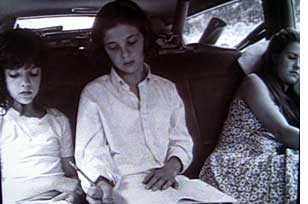 Little
Women In Transit,
1996 Little
Women In Transit,
1996
Director/Screenplay: Barbara Heller
Starring: Magdalena Gross, Cara Jedell, Danielle Shuman, David
Little, Sally Heller
7 minutes
Little
Women In Transit, from
writer/director Barbara Heller, based on her short story, is a brief black
& white snippet from a family's hellish vacation car trip. Jennie, 12
years old, is seated between her sisters in the back seat as she tries
to write a melodramatic story. The girls poke and pull each other's hair.
The two sisters tease Jennie that her favorite writer, Louisa May Alcott,
is a lesbian. Short and sweet, (7 minutes), that's about it in a nutshell.
That, and the father yells at them to behave.
|
|
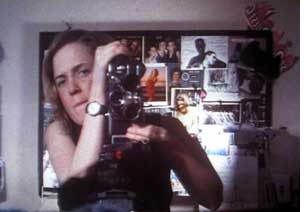 Playing the Part, 1995
Playing the Part, 1995
Director/Screenplay: Mitch McCabe
Starring: Mitch McCabe, rest of cast not credited
38 minutes
Playing
the Part is a mockumentary by Mitch McCabe in which she
plays a film student who tries to come out to her very conservative family
in Grosse Point, Michigan. Her family is a parody of the typical suburban,
all-American dream in which any deviance from being as perfect as possible
is not to be tolerated. She learns that resistance is futile as her many
attempts to tell her parents fail miserably.
The film is shot
mostly as a series of home movies and interviews while McCabe's deadpan
musings skewer upper class mores and her bohemian lesbian rebellions.
She thinks it's "sorta weird" that her father's private practice as a
plastic surgeon, specializing in mastectomy restorations, pays for her
college tuition. Her mother's life is a debutante ball on a tape loop,
and coming out would "destroy everything [her] family has built." Most
of Playing The Part is amusing
but after awhile the repetition becomes tedious and the ending is a cop
out.
|
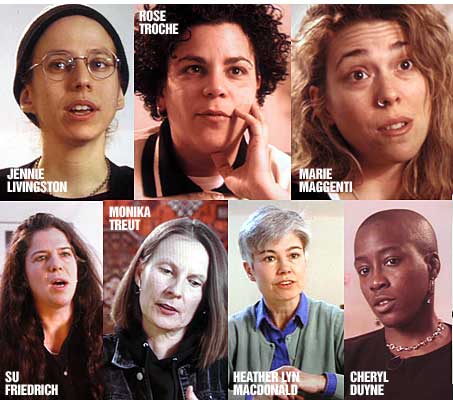 |
|
Lavender
Limelight: Lesbians In Film
Director: Marc Mauceri
Starring: Jennie Livingston, Rose Troche, Monika Treut, Maria Meggenti,
Su Friedrich, Heather Lyn MacDonald, Cheryl Duyne
56 minutes
The final entry
is Lavender Limelight: Lesbians In Film. Marc
Mauceri's documentary concerns seven noted lesbian directors, most of
whom came to prominence during the second wave of the New Queer Cinema
during the mid-1990s. While hardly a comprehensive and all-encompassing
study (this film could have easily been much longer), each of the short
interviews, illustrated by clips from their movies, offers fascinating
insights into the thoughts, politics and filmmaking strategies of each
of these remarkable women.
It should be noted
that this documentary was filmed in 1997 and so, for example, director
Rose Troche's involvement with The
L Word, and Maria Maggenti's acclaimed Puccini For Beginners,
is many years in the future.
|
|
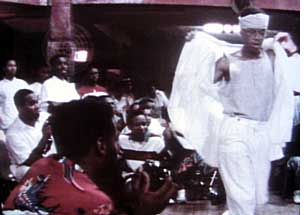 First
up is Jennie Livingston, best known for the popular Drag Ball documentary,
Paris Is Burning (1990). Livingston talks about attending one of
these balls and watching the ways in which the participants deconstructed
their very identity, class and gender. She recounts contacting famed German
filmmaker Werner Herzog (Aguirre, the Wrath Of God) who told her
that film is not about making money and that she should follow her heart
and make the films that she wants to direct. She became aware
of her own sexuality as she made this classic film about queer subculture,
and describes filmmaking as a process of coming out. First
up is Jennie Livingston, best known for the popular Drag Ball documentary,
Paris Is Burning (1990). Livingston talks about attending one of
these balls and watching the ways in which the participants deconstructed
their very identity, class and gender. She recounts contacting famed German
filmmaker Werner Herzog (Aguirre, the Wrath Of God) who told her
that film is not about making money and that she should follow her heart
and make the films that she wants to direct. She became aware
of her own sexuality as she made this classic film about queer subculture,
and describes filmmaking as a process of coming out.
|
|
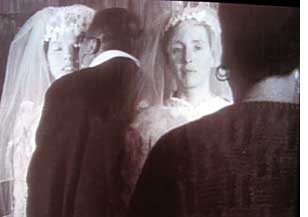 Next
is Rose Troche,
the director of 1994's groundbreaking Go Fish.
She rebelled against the notion that, as a Puerto Rican woman, she should
become a nurse, get married and have 20 kids. Instead, she recounts her
journey from being a maker of non-narrative, experimental short films
to Go Fish which was called "an arthouse lesbian film" that hadn't
been seen before. Troche wishes to remain a director where she
is in control without having Hollywood producers calling the shots. "I
always want to be on the margins," she declares, "But I want to be on
the margins because I'm an independent filmmaker and not because I'm a
lesbian." Next
is Rose Troche,
the director of 1994's groundbreaking Go Fish.
She rebelled against the notion that, as a Puerto Rican woman, she should
become a nurse, get married and have 20 kids. Instead, she recounts her
journey from being a maker of non-narrative, experimental short films
to Go Fish which was called "an arthouse lesbian film" that hadn't
been seen before. Troche wishes to remain a director where she
is in control without having Hollywood producers calling the shots. "I
always want to be on the margins," she declares, "But I want to be on
the margins because I'm an independent filmmaker and not because I'm a
lesbian."
|
|
 German
filmmaker Monika Treut grew
up watching the films of edgy directors like Rosa
Von Praunheim and Rainer
Werner Fassbinder on television and considers herself to be androgynous.
With no formal film training, she made Verfuhrung: Die Grausame Frau
(Seduction: The Cruel Woman) in 1985. This audacious film debut explored
S&M rituals and compares the lot of the masochist to a director on a film
set who demands a scenario. Her follow up film was Die Jungfrauenmaschine
(Virgin Machine - 1988). She remarks that lesbian films are the current
flavor of the month and expresses a desire to turn instead to the documentary
where she can be surprised by the filmmaking journey's ultimate destination. German
filmmaker Monika Treut grew
up watching the films of edgy directors like Rosa
Von Praunheim and Rainer
Werner Fassbinder on television and considers herself to be androgynous.
With no formal film training, she made Verfuhrung: Die Grausame Frau
(Seduction: The Cruel Woman) in 1985. This audacious film debut explored
S&M rituals and compares the lot of the masochist to a director on a film
set who demands a scenario. Her follow up film was Die Jungfrauenmaschine
(Virgin Machine - 1988). She remarks that lesbian films are the current
flavor of the month and expresses a desire to turn instead to the documentary
where she can be surprised by the filmmaking journey's ultimate destination.
|
|
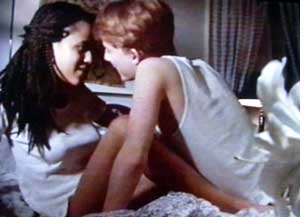 Maria
Maggenti is the auteur of 1995's charming The
Incredibly True Adventure Of Two Girls In Love. Maggenti recounts
being an ACT-UP activist from 1987-1990 and then going to film school
where she became "less interested in facts and more interested in truth"
and moved from documentary to fiction films. The aforementioned breakthrough
film explored an interracial love affair between two teen-aged girls from
opposite sides of the tracks and eschewed all cliches. For her, independent
filmmaking should always be about the individual voice. Maria
Maggenti is the auteur of 1995's charming The
Incredibly True Adventure Of Two Girls In Love. Maggenti recounts
being an ACT-UP activist from 1987-1990 and then going to film school
where she became "less interested in facts and more interested in truth"
and moved from documentary to fiction films. The aforementioned breakthrough
film explored an interracial love affair between two teen-aged girls from
opposite sides of the tracks and eschewed all cliches. For her, independent
filmmaking should always be about the individual voice.
|
|
 Su
Friedrich, the daughter of German immigrants, first crafted documentaries
about her parents' experiences in Nazi Germany before turning to a fiction
film about a girl who falls in love with a nun in 1987's Damned If
You Don't. She is best known for Hide And Seek (1996), a film
about young girls who grow up to be lesbians. Su
Friedrich, the daughter of German immigrants, first crafted documentaries
about her parents' experiences in Nazi Germany before turning to a fiction
film about a girl who falls in love with a nun in 1987's Damned If
You Don't. She is best known for Hide And Seek (1996), a film
about young girls who grow up to be lesbians.
|
|
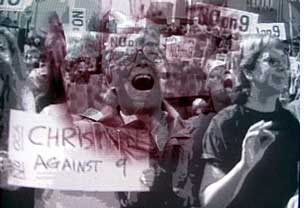 Heather
Lyn MacDonald speaks of making documentaries in Russia and coming out,
after 12 years of marriage, when she was 30. Her best known title, Ballot
Measure 9 (1995), recorded the events surrounding an anti-gay ballot
introduced in Oregon in 1992 that led indirectly to an increase in violence
against gays and lesbians. She was drawn to the subject for the opportunity
to contrast such conflicting emotions and some of the footage is pretty
scary. Heather
Lyn MacDonald speaks of making documentaries in Russia and coming out,
after 12 years of marriage, when she was 30. Her best known title, Ballot
Measure 9 (1995), recorded the events surrounding an anti-gay ballot
introduced in Oregon in 1992 that led indirectly to an increase in violence
against gays and lesbians. She was drawn to the subject for the opportunity
to contrast such conflicting emotions and some of the footage is pretty
scary.
|
|
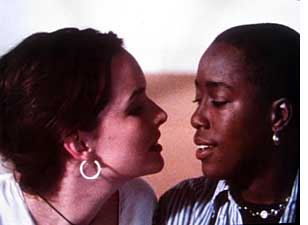 Finally,
Cheryl Duyne speaks of filling a void in which she saw no films being
made by African American lesbians. Following a series of shorts, she wrote
and directed The Watermelon Woman
in 1997 - which also won a Teddy Bear at the Berlin International Film
Festival. This groundbreaking film was the story of a black video store
clerk, played by Duyne, who watches an old Southern plantation film and
is struck by a colored maid who is identified in the credits only as "the
Watermelon Woman." Seeing this as an interesting subject for a documentary,
she discovers that the unknown actress had an affair with her director
(a white woman based loosely on real life 1930s lesbian director Dorothy
Arzner), and then enters into an affair with a white woman that parallels
the film she is making. Duyne optimistically predicts that queer cinema
will have a presence beyond this "magical moment" in the mid-90s. Finally,
Cheryl Duyne speaks of filling a void in which she saw no films being
made by African American lesbians. Following a series of shorts, she wrote
and directed The Watermelon Woman
in 1997 - which also won a Teddy Bear at the Berlin International Film
Festival. This groundbreaking film was the story of a black video store
clerk, played by Duyne, who watches an old Southern plantation film and
is struck by a colored maid who is identified in the credits only as "the
Watermelon Woman." Seeing this as an interesting subject for a documentary,
she discovers that the unknown actress had an affair with her director
(a white woman based loosely on real life 1930s lesbian director Dorothy
Arzner), and then enters into an affair with a white woman that parallels
the film she is making. Duyne optimistically predicts that queer cinema
will have a presence beyond this "magical moment" in the mid-90s.
While the middle
three films are a bit "iffy," Lesbian Nation
is bookended by two terrific films that make this DVD an essential addition
to the collection of any serious student of queer cinema.
More On Rose Troche:
Go Fish
The L Word
More On Cheryl
Duyne:
The Watermelon Woman
More On Marie
Maggenti:
The Incredibly True
Adventure Of Two Girls In Love
More On Monika
Treut:
Ghosted
|
|
|


